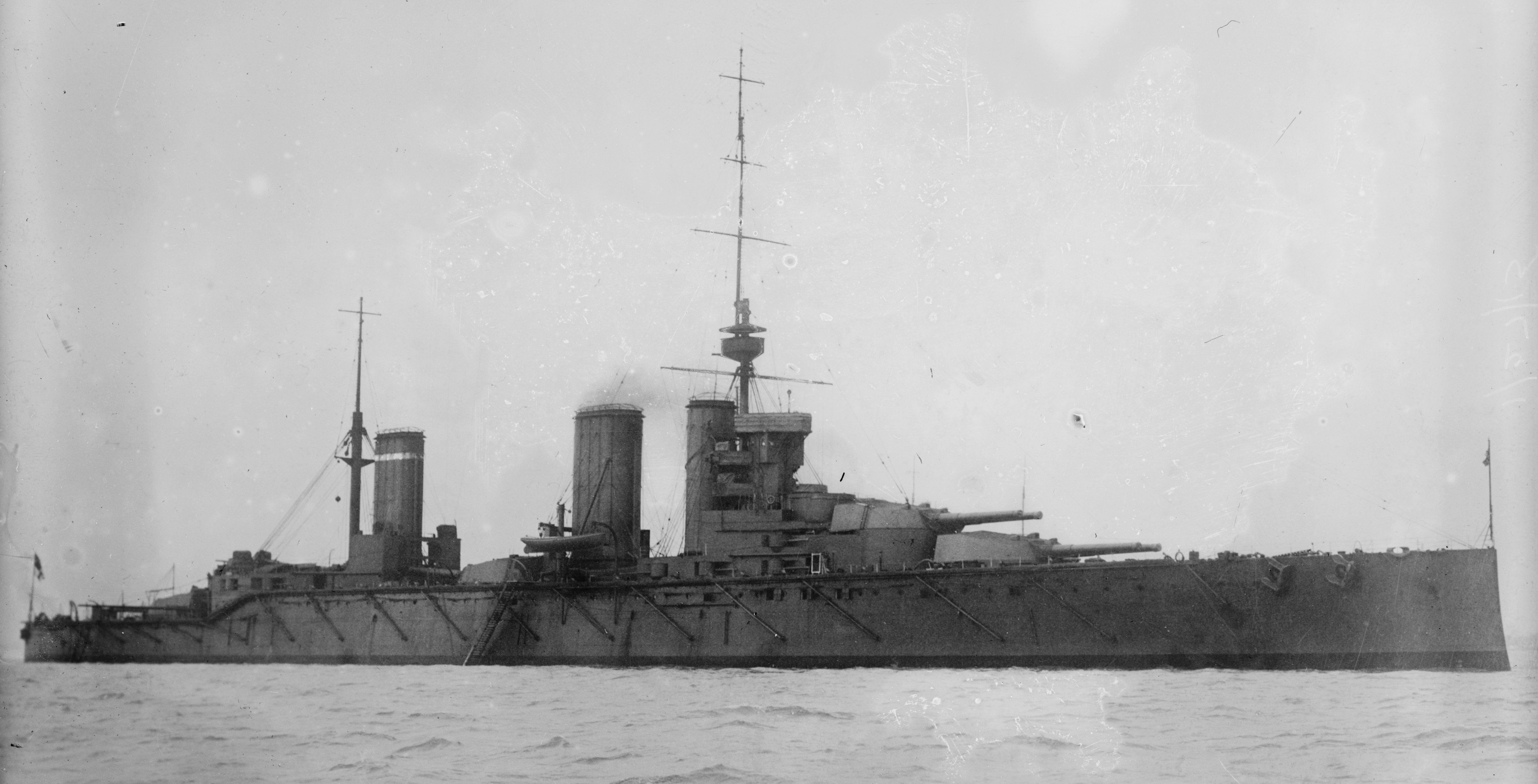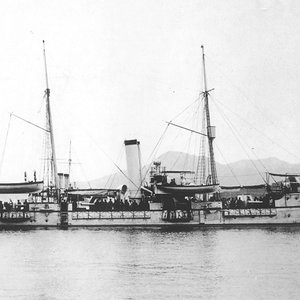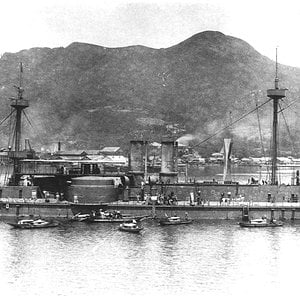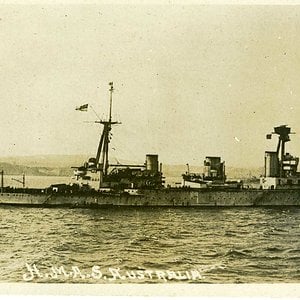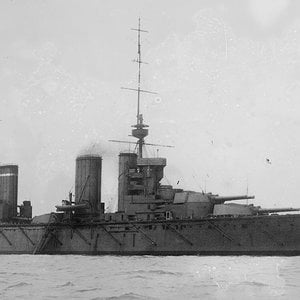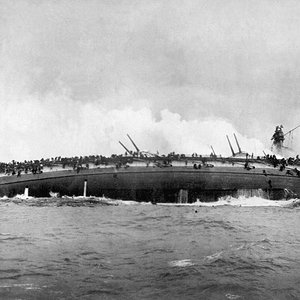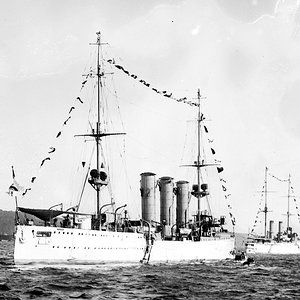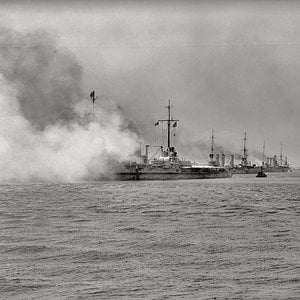Navigation
Install the app
How to install the app on iOS
Follow along with the video below to see how to install our site as a web app on your home screen.
Note: This feature may not be available in some browsers.
More options
You are using an out of date browser. It may not display this or other websites correctly.
You should upgrade or use an alternative browser.
You should upgrade or use an alternative browser.
Propulsion
Princess Royal had two paired sets of Parsons direct-drive steam turbines housed in separate engine-rooms. Each set consisted of a high-pressure ahead and astern turbine driving an outboard shaft, and a low-pressure ahead and astern turbine driving an inner shaft. Designed power was 70,000 shaft horsepower (52,199 kW) for a speed of 28 knots (52 km/h; 32 mph).[6] In September 1912, Princess Royal began her sea trials and developed 78,803 shp (58,763 kW) for a speed of 28.5 knots (52.8 km/h; 32.8 mph).[7] During maximum power trials in July 1913, the battlecruiser achieved 96,238 shp (71,765 kW) for a speed of 27.97 knots (51.80 km/h; 32.19 mph) while at the unusually high displacement of 29,660 long tons (30,140 t).[8]
The steam plant consisted of 42 Yarrow large-tube boilers arranged in seven boiler rooms.[9] Maximum bunkerage was 3,500 long tons (3,600 t) of coal and an additional 1,135 long tons (1,153 t) of fuel oil to be sprayed on the coal to increase its burn rate.[10] At 10 knots (19 km/h; 12 mph), the ship's range was 5,610 nautical miles (10,390 km; 6,460 mi).[3]
[edit] Armament
Princess Royal was armed with eight BL 13.5-inch Mark V guns ("BL" for breech-loading) in four twin hydraulically powered turrets, designated 'A', 'B', 'Q' and 'X' from bow to stern. Her secondary armament consisted of 16 BL 4-inch Mark VII guns, most of which were mounted in casemates in the superstructure.[11] The two guns mounted on the deck above the forward group of casemates were fitted with gun shields in 1913 and 1914 to better protect their crews from enemy fire. The starboard after 4-inch (102 mm) gun was removed in early 1917,[12] fitted to a high-angle Mark II mount capable of 60° of elevation, and returned in April along with a second, similarly modified gun from sister ship HMS Lion.[11] Two submerged torpedo tubes were fitted on the beam, and fourteen 21-inch torpedoes were carried.[3][11]
A 3-inch 20 cwt AA gun on the quarterdeck of HMAS Australia
The battlecruiser was built without anti-aircraft (AA) guns, but from October 1914 to December 1916 was fitted with a single QF 6 pounder Hotchkiss gun ("QF" for quick-firing) on a high-angle Mark Ic mount, which had a maximum depression of 8° and a maximum elevation of 60°.[11] A 6-pound (2.7 kg) shell was fired at a muzzle velocity of 1,765 ft/s (538 m/s) and a rate of fire of 20 rounds per minute. It had a maximum ceiling of 10,000 ft (3,000 m), but an effective range of only 1,200 yards (1,100 m).[13][14] A single QF 3-inch 20 cwt[Note 1] AA gun was added in January 1915 and carried until April 1917. Its high-angle Mark II mount had a maximum depression of 10° and a maximum elevation of 90°. The gun fired a 12.5-pound (5.7 kg) shell at a muzzle velocity of 2,500 ft/s (760 m/s) at a rate of 12 to 14 rounds per minute. It had a maximum effective ceiling of 23,500 ft (7,200 m).[15][16]
Princess Royal received a fire-control director between mid-1915 and May 1916 that centralised fire-control under the director officer who now fired the guns. To align their guns on the target, the turret crewmen had to follow pointers whose position was transmitted from the director. This greatly increased accuracy as it was easier for the director to spot the fall of shells and eliminated the shell spread caused by the ship's roll as the turrets fired individually.[17] By early 1918, Princess Royal carried a Sopwith Pup and a Sopwith 1½ Strutter on flying-off ramps fitted on top of 'Q' and 'X' turrets. Each platform had a canvas hangar to protect the aircraft during inclement weather.[18]
[edit] Armour
The armour protection given to Lion and Princess Royal was heavier than on the Indefatigables. The waterline belt of Krupp cemented armour measured 9 inches (229 mm) thick amidships; this thinned to 4 inches towards the ships' ends, but did not reach the bow or stern. The upper armour belt had a maximum thickness of 6 inches over the same length as the thickest part of the waterline armour and thinned to 5 inches (127 mm) abreast of the end turrets. The gun turrets and barbettes were protected by 8 to 9 inches (203 to 229 mm) of armour, except for the turret roofs which used 2.5 to 3.25 inches (64 to 83 mm). The thickness of the nickel steel deck ranged from 1 to 2.5 inches (25 to 64 mm). Nickel steel torpedo bulkheads 2.5 inches (64 mm) thick were fitted abreast of the magazines and shell rooms.[19] After the Battle of Jutland revealed a vulnerability to plunging shellfire, 1 inch of additional armour, weighing approximately 100 long tons (102 t), was added to the magazine crowns and turret roofs.[20]
Princess Royal had two paired sets of Parsons direct-drive steam turbines housed in separate engine-rooms. Each set consisted of a high-pressure ahead and astern turbine driving an outboard shaft, and a low-pressure ahead and astern turbine driving an inner shaft. Designed power was 70,000 shaft horsepower (52,199 kW) for a speed of 28 knots (52 km/h; 32 mph).[6] In September 1912, Princess Royal began her sea trials and developed 78,803 shp (58,763 kW) for a speed of 28.5 knots (52.8 km/h; 32.8 mph).[7] During maximum power trials in July 1913, the battlecruiser achieved 96,238 shp (71,765 kW) for a speed of 27.97 knots (51.80 km/h; 32.19 mph) while at the unusually high displacement of 29,660 long tons (30,140 t).[8]
The steam plant consisted of 42 Yarrow large-tube boilers arranged in seven boiler rooms.[9] Maximum bunkerage was 3,500 long tons (3,600 t) of coal and an additional 1,135 long tons (1,153 t) of fuel oil to be sprayed on the coal to increase its burn rate.[10] At 10 knots (19 km/h; 12 mph), the ship's range was 5,610 nautical miles (10,390 km; 6,460 mi).[3]
[edit] Armament
Princess Royal was armed with eight BL 13.5-inch Mark V guns ("BL" for breech-loading) in four twin hydraulically powered turrets, designated 'A', 'B', 'Q' and 'X' from bow to stern. Her secondary armament consisted of 16 BL 4-inch Mark VII guns, most of which were mounted in casemates in the superstructure.[11] The two guns mounted on the deck above the forward group of casemates were fitted with gun shields in 1913 and 1914 to better protect their crews from enemy fire. The starboard after 4-inch (102 mm) gun was removed in early 1917,[12] fitted to a high-angle Mark II mount capable of 60° of elevation, and returned in April along with a second, similarly modified gun from sister ship HMS Lion.[11] Two submerged torpedo tubes were fitted on the beam, and fourteen 21-inch torpedoes were carried.[3][11]
A 3-inch 20 cwt AA gun on the quarterdeck of HMAS Australia
The battlecruiser was built without anti-aircraft (AA) guns, but from October 1914 to December 1916 was fitted with a single QF 6 pounder Hotchkiss gun ("QF" for quick-firing) on a high-angle Mark Ic mount, which had a maximum depression of 8° and a maximum elevation of 60°.[11] A 6-pound (2.7 kg) shell was fired at a muzzle velocity of 1,765 ft/s (538 m/s) and a rate of fire of 20 rounds per minute. It had a maximum ceiling of 10,000 ft (3,000 m), but an effective range of only 1,200 yards (1,100 m).[13][14] A single QF 3-inch 20 cwt[Note 1] AA gun was added in January 1915 and carried until April 1917. Its high-angle Mark II mount had a maximum depression of 10° and a maximum elevation of 90°. The gun fired a 12.5-pound (5.7 kg) shell at a muzzle velocity of 2,500 ft/s (760 m/s) at a rate of 12 to 14 rounds per minute. It had a maximum effective ceiling of 23,500 ft (7,200 m).[15][16]
Princess Royal received a fire-control director between mid-1915 and May 1916 that centralised fire-control under the director officer who now fired the guns. To align their guns on the target, the turret crewmen had to follow pointers whose position was transmitted from the director. This greatly increased accuracy as it was easier for the director to spot the fall of shells and eliminated the shell spread caused by the ship's roll as the turrets fired individually.[17] By early 1918, Princess Royal carried a Sopwith Pup and a Sopwith 1½ Strutter on flying-off ramps fitted on top of 'Q' and 'X' turrets. Each platform had a canvas hangar to protect the aircraft during inclement weather.[18]
[edit] Armour
The armour protection given to Lion and Princess Royal was heavier than on the Indefatigables. The waterline belt of Krupp cemented armour measured 9 inches (229 mm) thick amidships; this thinned to 4 inches towards the ships' ends, but did not reach the bow or stern. The upper armour belt had a maximum thickness of 6 inches over the same length as the thickest part of the waterline armour and thinned to 5 inches (127 mm) abreast of the end turrets. The gun turrets and barbettes were protected by 8 to 9 inches (203 to 229 mm) of armour, except for the turret roofs which used 2.5 to 3.25 inches (64 to 83 mm). The thickness of the nickel steel deck ranged from 1 to 2.5 inches (25 to 64 mm). Nickel steel torpedo bulkheads 2.5 inches (64 mm) thick were fitted abreast of the magazines and shell rooms.[19] After the Battle of Jutland revealed a vulnerability to plunging shellfire, 1 inch of additional armour, weighing approximately 100 long tons (102 t), was added to the magazine crowns and turret roofs.[20]

